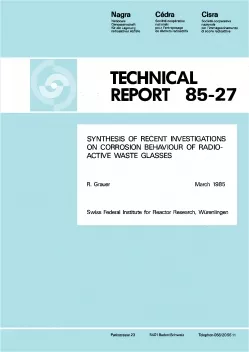
Technical Report NTB 85-27
Synthesis of recent investigations on corrosion behaviour of radioactive waste glasses
By way of a supplement to an earlier report (NTB 83-01, EIRReport Nr. 477/30/), work which has appeared in the meantime on the corrosion behaviour of borosilicate glasses as a solidification matrix for high-level radioactive waste has been evaluated.
Many works have confirmed that for a particular glass, besides temperature and pH-value, the silicate concentration of the solution exerts the strongest influence on corrosion rate. The effect of silicate can be described in terms of simple reaction kinetics models which provide a sounder basis for prediction of long-term behaviour of glasses than previously existed.
Meanwhile, the effects of backfill- and canister-materials and their corrosion products have been given the attention they merit. These materials affect glass corrosion primarily through regulation of silicic acid concentration. A particular finding which is of interest is the strong inhibition of glass corrosion by lead ions.
Stationary corrosion rates in the order of magnitude of 10-5 g/cm2·d can be derived from long-term corrosion experiments in stagnant water at 90°C. At the envisaged repository temperature of 55°C they will be one to two orders of magnitude less. The effects of radioactive decay on corrosion rate are either very small or not detectable at all.
No further new viewpoints have been put forward with regard to a possible thermal restructuring of glasses under repository conditions: recrystallisation (devitrification) is not to be feared.
With regard to future experiments, further work on quantification of the effects of canister- and backfill-materials and experiments with corrosion inhibitors would be of primary interest.
